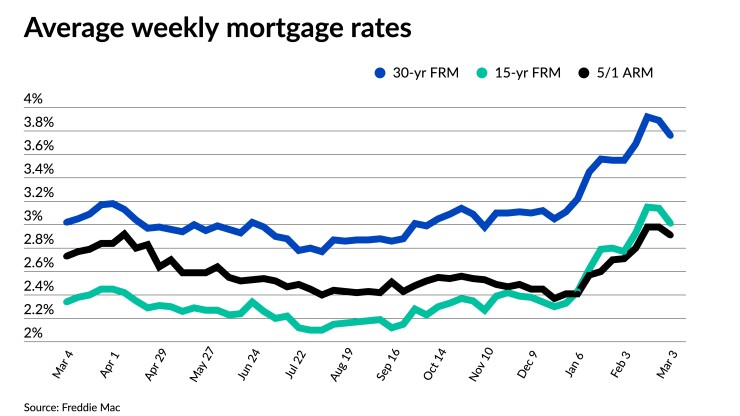When considering the potential risks facing the average independent mortgage banker in these days of war, inflation and rising
The FHFA just proposed new
Acting FHFA Director Sandra Thompson, who spent a good bit of her career at the Federal Deposit Insurance Corp., now wants to shoot a hole in the proverbial lifeboat of housing finance. Just as a new economic storm is rising and industry volumes are falling, she has decided to double or even triple the effective capital requirements for the entire industry.
Whence comes the storm? The tempest comes from across town at the Federal Reserve in the form of sudden changes to monetary policy, this after years of excessive ease. The inflationists on the Federal Open Market Committee, led by former Chair and now Treasury Secretary Janet Yellen, whined for years about low inflation. They decided to buy trillions in Treasury debt and MBS to fix “the problem.”

Now thanks to such incautious thinking about inflation, we face a war in Europe with the prospect of hyperinflation. Price increases are driven by rising costs for food, energy and, yes,
The wreckage from the Fed’s inattention to its dual mandate stretches from the world of housing finance to the global equity markets. IMBs and community banks are choking on conventional and government production that was trading above 104 several months ago but is now trading below 97 cents on the dollar. The abrupt and disorderly change in Fed interest rate guidance will cost banks and IMBs hundreds of millions in losses in Q1 2022.

Mortgage firms that went public via SPAC during the land rush days of 2020-21 will be under pressure to adjust the value of equity given the sharp decline in valuations for public mortgage companies, and the example of
Simply stated, the working capital of IMBs is 100% correlated to interest rate movements. Commercial banks, on the other hand, have capital that transcends interest rates. Banks transform short-term deposits into long-term earning assets. IMBs, on the other hand, originate and sell assets to banks, hopeful with as little loiter time as possible. Delay = risk.
In basic terms, the FHFA issuer rules will require all IMBs that are conventional issuers to carry two to three times more restricted cash than under current rules. While most issuers could live with an increase in net worth requirements, the other changes proposed by the FHFA will deliver a crushing blow to the industry, this even as IMBs are cutting capacity and staff.
IMBs are, in economic terms, the mirror image of a commercial bank. Banks have statutory reserves and public subsidies that allow them to maintain capital levels through different interest rate environments. IMBs borrow capital from banks and bond investors.
IMBs are like flowers in Texas that thrive in the wet weeks of spring, but shrivel and vanish in the heat of summer. Many IMBs saw dramatic increases in volumes, profits and equity during the period of extraordinary ease by the FOMC from April 2020 through to 2022. Now, with public IMBs trading at a steep discount to book value, these same companies must now spend capital.
If the current proposal is approved by the FHFA, then it will force conventional volumes down sharply. More restricted cash means less leverage means lower volumes and reduced profits. And the FHFA has also decided, without any justification, to add further capital surcharges to IMBs that hedge their interest rate exposure in the to-be-announced or TBA market.
Say, for example, that we have a $1.5 billion short position in TBAs to hedge our forward loan production. Say rates drop and TBA prices improve by 2%. We’d get a margin call the next day from our broker dealer seeking $30mm of cash margin. But the FHFA wants us to put up another $30 million in effective margin on top of that restricted cash. There is no explanation from the agency why this surcharge is even necessary in addition to the securities margin required by FINRA and the SEC.
The cash we put up would be restricted cash and not available to meet the FHFA’s minimum liquidity calculation. Then, in addition to the additional $30 million FHFA margin surcharge, we would also need to meet the minimum liquidity rules, which would be $30 million more than today. It’s almost as though the FHFA does not want IMBs to hedge interest rate exposure.
In fairness to the FHFA, this proposal is an attempt to mitigate the market risks seen in April of 2020, when the Fed went “big” in terms of open market intervention and nearly tipped over half a dozen IMBs and REITs in the process. Dealers literally had every dollar in cash available from users of the TBA market.
But here’s the punchline for Director Thompson: Had your proposed issuer eligibility rules been in place in April 2020, several large IMBs likely would have failed to meet margin and then defaulted. Former FHFA Director Mark Calabria confirmed during remarks to the Prosperity Caucus in March of 2021 that a government rescue was contemplated for several large IMBs.
In the event of default, the FHFA and Ginnie Mae would have been compelled to terminate servicing for several bankrupt issuers and attempt to move the assets to other firms. It is far from certain that sufficient hot capacity exists in the industry to effect an involuntary transfer of servicing under such conditions.
Bottom line is that anyone with even a rudimentary knowledge of capital markets and finance can see that the FHFA methodology is flawed. Instead of thinking clearly about how much liquidity is required to actually absorb the real risk to the enterprises, the FHFA seems to have decided to play bank regulator and run with a slightly modified version of the GNMA proposal from last summer.
The FHFA issuer eligibility proposal, if put into force, will severely impact the working capital and profitability of IMBs, and reduce volumes in the industry. It will increase the risk of default for the IMBs that remain in the conventional market and more generally hand the conventional market to the big banks on a silver platter.
The irony, of course, is that commercial banks may not care to take additional exposure in lower-income conventional borrowers. In fact, commercial banks have been reducing their appetite for low-income residential mortgage exposures over the past several decades. Our friends at the FHFA should ponder that fact and carefully consider the real-world implications of this badly considered proposal.





